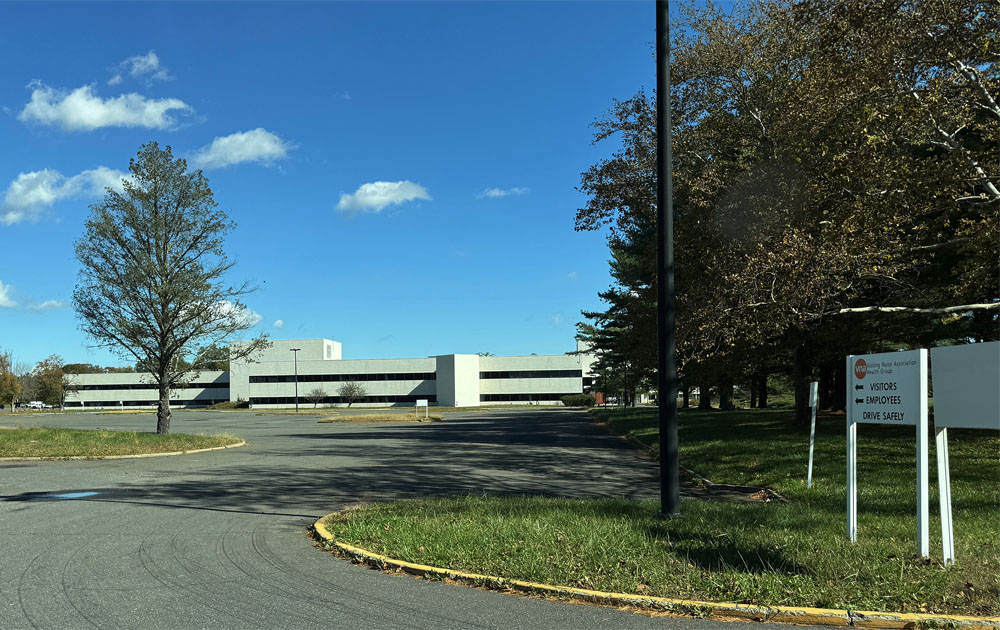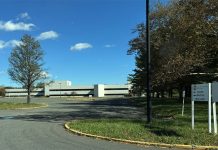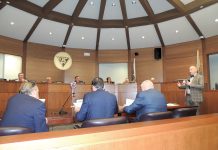
By Sunayana Prabhu
HOLMDEL – Residents voiced strong opposition Monday night to initial plans for Azura at Holmdel, a nearly 300-unit senior residential community planned at the former Vonage headquarters. The concerns they cited included potential groundwater contamination due to the project’s proximity to Willow Brook, a state-designated Category-1 stream that feeds into Swimming River Reservoir. The reservoir supplies drinking water to more than 335,000 Monmouth County residents – 36 million gallons a day – through the New Jersey American Water Company.
Azura at Holmdel will unfold in four phases across nearly 88 acres, incorporating both new construction and the adaptive reuse of the existing two-story building at 23 Main St. (Newman Springs Road).
The applicant, 23 Main Street Urban Renewal, LLC, an affiliate of Bloomfield-based developer Community Healthcare Associates, which owns the Vonage property, came before the special planning board meeting Nov. 10 seeking final site plan approvals for Phase 1 of the project.
No vote was taken to advance the project after nearly three hours of testimony and public comment Monday. The planning board decided to carry the application to its Dec. 16 meeting for further review expected traffic engineering testimony.
At Monday’s meeting, the main focus was wastewater treatment.
Phase 1 calls for repurposing the existing Vonage building to create 104 for-sale condominium units for seniors, including 21 affordable units to comply with New Jersey’s Fair Share Housing Law. The plans also include upgrading and modernizing the property’s wastewater system, which consists of an existing on-site treatment plant and a lagoon that holds the wastewater effluent. The entire system is almost a half-century old and is regulated by the New Jersey Department of Environmental Protection (NJDEP), which currently limits its capacity to 40,000 gallons per day of wastewater effluent.
There is “no intent to increase the permit capacity of the wastewater treatment plant as part of this project,” said Jordan Volk, the applicant’s engineer and a licensed professional specializing in drinking water and wastewater system permits. He testified extensively about the existing and proposed operations of the wastewater treatment facility.
“This project is just proposing to modernize and enhance the processes at the wastewater treatment plant,” he said.
How the Facility Works
Volk said the existing wastewater plant collects flow from the office building and channels it through a pump station to an equalization tank, which smooths and meters the incoming water while adding aeration. The flow then passes through a clarifier to remove solids, undergoes additional aeration, is filtered further with sand, and finally disinfected using UV light.
From the treatment plant, the water is treated and processed per DEP requirements and is discharged either to the on-site lagoon during the warmer months (April to November). The flow is discharged to the east branch of the Willow Brook during winter, when the lagoon is frozen, he said.
Treated water from the lagoon can be pumped through pipes for spray irrigation on the field. “What the lagoon serves for is evaporation of that treated water and also percolation of that through the ground, like a septic system would,” Volk explained. But, he added, that spray irrigation is done “only in emergencies” when the water rises above a certain level.
Planned upgrades to the treatment plant include rehabilitating the existing plant for DEP’s permits.
Planning Board Concerns
Holmdel Planning Board member Tom King asked how the four phases of the project will be handled by the existing wastewater treatment plant without increasing the 40,000-gallons-per-day limit.
“For the entire project in all four phases, the flow is projected at 45,650 gallons per day. The first three phases are 39,210 gallons per day,” Volk replied.
The projected numbers are based on DEP regulations and refer to the flow of wastewater that enters pipes through daily use.
“After the first three phases, we’ll look at what that average flow is, and then assess the fourth phase based on what capacity is left in the plant, under that 40,000-gallons-per-day limit. If it’s necessary to change the number of units in the fourth phase, that will be done,” Volk said.
King asked where the additional 5,000 gallons a day generated above DEP’s limit would go. The applicant’s attorney, Karl Kemm, replied, “into the lagoon.”
Kemm said the projected numbers are “rather old” and “an overestimate.” Volk also added that all of the plans would be reviewed by DEP.
“Having lived through and close to a two-stage sewer plant – it was at Greenwood Avenue in Cliffwood Beach – it was unlivable,” board member Wes Fagan said, sharing a past experience. He said odors from the lagoon were so unbearable that a neighbor once brought effluent samples to township meetings to demonstrate the issue. Fagan suggested it might be worthwhile for the board to examine samples of the existing lagoon on the Vonage site at a future meeting, and also recommended organizing a site visit for greater transparency.
Fagan also asked what recourse residents would have if they experienced issues such as odor, mosquitoes or effluent spraying, noting that DEP records found 19 violations out of 25 inspections there since 2000.
He questioned how such problems would be resolved and who would bear responsibility if the system failed. “Who’s paying these fines? Is this a developer? Is this the homeowners’ association or ultimately the township that’s stuck with this?”
Kemm apologized, saying the developer was “not aware of the prior violations.” He noted the reason for the upgrade is to ensure the plant “complies with all current standards, and it operates properly. So, the fact that there were violations shows that it needs to be upgraded,” he said.
Fagan still argued that “something must have gone wrong in that original percolation lagoon in the past” for the DEP to allow its use only for six months of the year and let the effluent flow directly into the stream for the remainder of the year.
“I think it’s outrageous,” Fagan said, adding that he is concerned that the existing treatment plant “does not supply a significant, higher rate of filtration to even consider putting (the effluent) into the stream.”
Public Pushback
Dozens of residents voiced alarm over the plan to convert one of the largest parcels in town into a 300-unit residential community with plans for an on-site medical facility and community center – all supported by an aging wastewater treatment plant built in the 1970s and an unlined percolation lagoon.
“When people take medications, their bodies do not fully absorb or metabolize all the active compounds. The remainder is excreted in urine and feces entering the sewage system. How does the facility plan to deal with these compounds?” asked resident Kristin Celauro-Franco.
“There are no current regulations for those aspects in DEP,” Volk replied.
“Just because the DEP says it’s OK, why is this OK for our community?” Celauro-Franco said.
Peter Franco, resident and owner of Hop Brook Farm on Holmdel Road, was worried that the unlined percolating lagoon would contaminate his produce and two wells on the farm. “What happens when this system fails? What’s your backup plan? You have 300 units. You have care facilities… What happens when this fails?” he asked.
“This plant has to meet all the permit conditions through DEP. The first step is the equalization tank. So, if ever something needs to be replaced, equipment needs to be worked on, there’s an equalization tank where the sewage can be pumped out offsite until repairs can be made.”
Resident Jay Yannello was on an ad-hoc committee established by the township that had previously reviewed options for the redevelopment of the Vonage property. That committee concluded the current plan was acceptable, provided the wastewater treatment plant would operate properly for the community’s benefit.
However, at the public hearing, Yannello questioned the board’s decision to move forward without conducting a percolation test. “The fact that they’re coming here and asking you to vote without a percolation sample is completely outrageous and fraudulent to that committee I was on. And I hope the TC (township committee) is all listening because they should stop this meeting right now and not allow a vote,” Yannello said.
Board chairman Scott Silberman said calling for percolation tests “is beyond our jurisdiction. We’re voting on whether they’ve met the requirements of their application at this point, and they’re proceeding to move forward. They still have to go through the process if they need to provide the percolation test and whatever testing they have to do to satisfy the government’s and the agency’s requirements.”
Meanwhile, Citizens for Informed Land Use (CILU), a grassroots nonprofit organization, has launched an online petition addressed to the Holmdel Township Committee members to “Protect Holmdel’s Future: Stop High Density Development At Vonage.” The petition is now live on actionnetwork.org and has garnered 961 signatures from community members so far.
The article originally appeared in the November 13 – 19, 2025 print edition of The Two River Times.














